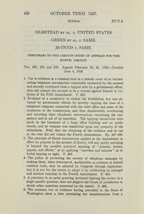The Annotated Bobblehead Justice Louis D. Brandeis
(Standard edition)
- Louis Brandeis's place in the history books would be certain even had he never joined the Supreme Court. Consider the "Brandeis brief" in Muller v. Oregon and his other work as "the people's lawyer"; his services to Zionism; his influence on the Woodrow Wilson and FDR presidential administrations; and his writings, such as The Right to Privacy, The Curse of Bigness, and, of course, his contributions to the Green Bag. See, e.g., The lncorporation of Trade Unions, 1 Green Bag 2d 306 (1998), and The Harvard Law School, 1 Green Bag 10 (1889). But he was a Justice too, from 1916 to 1939. A few of his more famous contributions in that capacity are symbolized.
- New State Ice v. Liebmann, 285 U.S. 262 (1932) (dissenting: "It is one of the happy incidents of the federal system that a single courageous state may ... serve as a laboratory"); Whitney v. California, 274 U.S. 357 (1927) (concurring: "the remedy to be applied is more speech, not enforced silence").
- Like many lawyers in bygone days, Brandeis carried his papers in a green bag. He was, to the best of our knowledge, the last Justice to do so. Merlo J. Pusey, Charles Evans Hughes 673 (1951).
- Engine #2499 pulled the car that struck Harry Tompkins, giving Brandeis the opportunity to declare for the Court, "There is no federal general common law." Erie Railroad v. Tompkins, 304 U.S. 64 (1938) (overruling Swift v. Tyson).
The Annotated Bobblehead Justice Louis D. Brandeis
(Harvard edition)
- There are three differences between the standard Justice Brandeis bobblehead doll and the Harvard edition. First, his standard necktie is blue; the Harvard tie is crimson. Second, his Harvard-edition cargo includes not only two volumes of the United States Reports, but also the first volume of the original Green Bag – the one containing the article he wrote about legal education at his alma mater.


